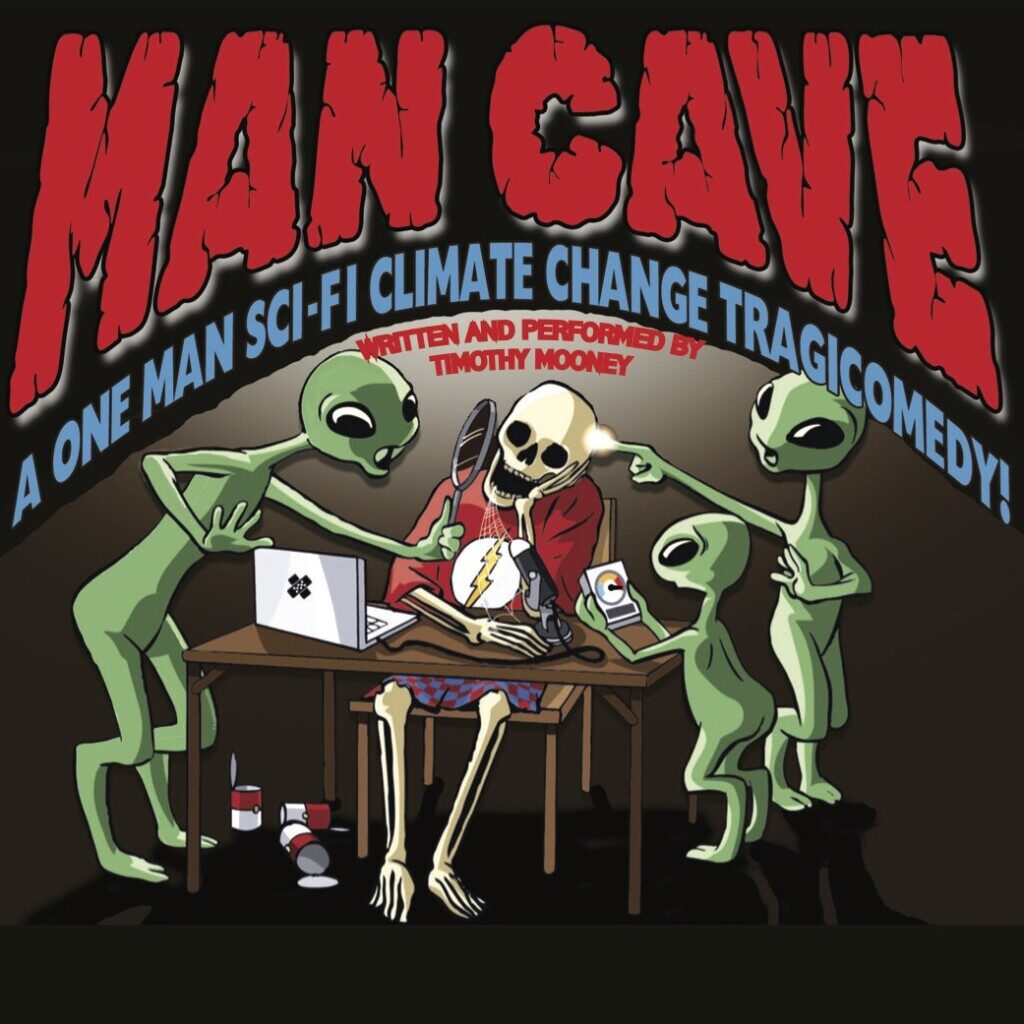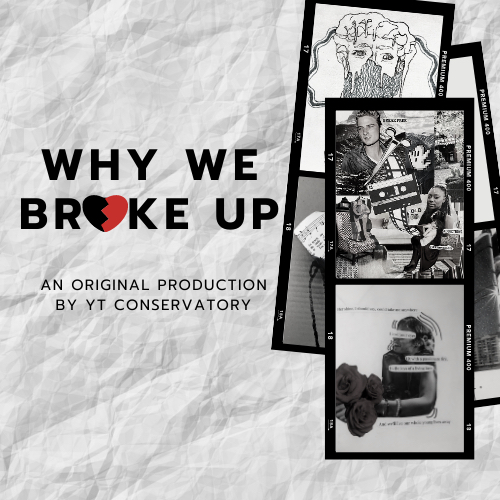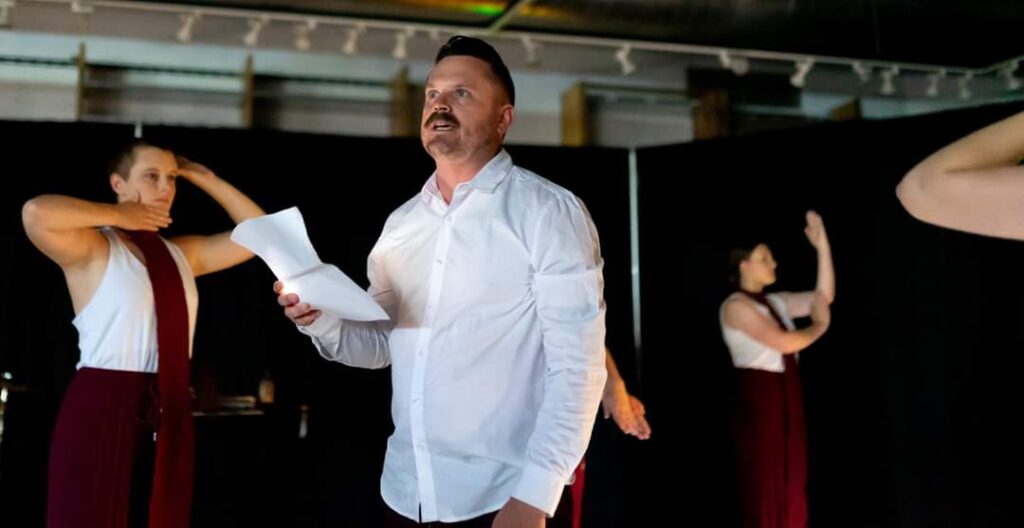Adopting a complete virtual format, the Great Salt Lake Fringe Festival (GSLF) marked its sixth year with the schedule of 38 shows being viewed more than 5,000 times from 48 states and 25 countries. Many individual performers raised tips and donations and GSLF organizers say that, pending final confirmed figures, the amounts per show are comparable to an average payout for a live Fringe performance. Organizers will announce Fringe awards later this week.
Fringe shows can be accessed on demand at the GSLF website for two more weeks. Viewers are encouraged to add tips and donations to organizations wherever appropriate.
Four additional shows were reviewed by The Utah Review this past weekend (Aug. 6-9):

Man Cave, a One-Man Sci-Fi Climate Change Tragicomedy, Timothy Mooney
One could believe that the COVID-19 pandemic is a good test run for how humans will respond to the dire potential of the climate change crisis. Facts and science seem to take much longer to seep into one’s reasonable mindset, only managing to work more quickly when the most ominous signs are visible to the largest number of observers at one time.
Or, much better, is the blunt appeal that seeps into one’s moral and ethical mindset before the last of the polar ice masses melts away or if an individual is compromised by a virus that could have been avoided if one had taken the proper responsible actions and cautions to protect them and their loved ones against infection.
Timothy Mooney’s Man Cave is one of the best wake up calls about the climate crisis. Mooney’s timing is right, considering how this crisis impatiently waits for Miss Rona to exit the stage so it can emerge front and center, finally.

Bracing in its dark comedic irony along with a wickedly incisive capacity to distill the concept with immediately approachable rationales, Man Cave reveals Mooney’s well honed craft in one-person theater. Mooney is based in Chicago.
Set just 10 years in the future, Man Cave takes place in the basement of a bunker in northern Canada, where he is the sole survivor. Mooney is broadcasting with the hopes that someone (an alien, Klingon, or droid) will intercept the transmission and heed the unvarnished lesson he provides.
In this apocalypse, political philosophy has no relevant currency anymore (e.g., the libertarians were not the fittest). Temperatures are relentless—even in the nighttime they do not dip below triple digits. Mooney wonders if he is talking into the void and if he should just let go, as this experiment in humanity once was supposed to work. Technology has outrun the human’s capacity for maturity, he says. “We default to the age of nine,” he adds.
Mooney imparts his own set of 10 commandments, perhaps destined to be picked up by a sentient species somewhere in the universe that will heed the plainspoken advice. The commandments are pithy but clear: “Stop idling,” “do not get too attached to any form of technology,” “things don’t happen in isolation.” “cost of buying a thing needs to reflect the expense,” “those who make up your laws must not profit therein,” and “don’t get over your skis: don’t multiply as if it was a race.”
Mooney’s language is vivid. The inventory of canned foods, which now taste like wet cardboard, imagines Andy Warhol’s worst nightmare. The accelerating trend of carbon and methane gases is likened to a hockey stick. Sex-starved humans may have hit a snag in the reproductive marathon around 1300 but it was going full tilt by 1800. The commandment of “acknowledge screamingly impossible improbability” tees up how humans “forgot the principal point of insurance.”
Mooney shines in the Fringe format and his delivery is pitch perfect. As he says, “pass it on.”

A Call To Serve: Confessions of a Mormon Hitman, Decaf Acting Company
The best moment in this virtual staged reading of Decaf Acting Company’s A Call To Serve: Confessions of a Mormon Hitman comes in the middle when the main character, who is deceased and is accounting for his life before a celestial judge (Zachariah Beesley, played by Dallon Thorup and the Judge, played by Ian Buckley), recounts an incident from Kandahar in Afghanistan.
Beesley was a Marine and he decided not to shoot a boy wearing an oversized vest who was clearly a suicide bomber. He took it as a sign of his Mormon faith, as his life had been spared despite severe injuries. He said it was an opportunity to keep pushing for spiritual enlightenment. The judge is unmoved by Beesley’s “flowery speeches.” Reminding Beesley that he had fought in the Korean War, the judge tells Beesley that he should have fired on the boy.
Directed by Sterling Shane Allen, the reading of the play, which was written by Jared Greathouse in 2017, had some excellent moments but it also indicated that the 90-minute script would benefit from some significant streamlining and recasting of lines to show more back-and-forth dialogue. Stage directions were voiced over by Bridgette Lehman.
Beesley is a deeply troubled soul whose life was distorted and maimed by vicious abuse from his stepfather, episodes of bullying and humiliation, the effects of PTSD that began when he watched his stepmother being subjected to his stepfather’s cruelty and war theater episodes from Kandahar and a Mormon mission cut short when he and his companion missionary experienced a psychedelic episode from peyote shared by a group of Paiutes. Beesley’s life seems utterly devoid of true joy or any sense of personal triumph.
He hears voices commanding him to kill individuals, including his wife and child. Beesley insists that he should not be denied his celestial reward because he has followed every demand to the letter of his faith’s doctrine. Among those he killed were those whose veneers as pillars of the community were stripped away to reveal just how sinful their own lives had been which they tried to guide. The play alludes to an overarching question: What and why are the consequences so dangerously toxic if one strives erroneously for blind obedience to a faith that demands absolutism and perfectionism? Can religions sincerely accommodate the acutely painful dilemmas, tensions and challenges of the contradictions arising from the literal absolutism of a faith’s tenets against those of a more nuanced moral consideration of the complexities of a human’s life, especially when episodes can destroy one’s innocence so early in their existence. Is the road to redemption that much imperiled?
There’s a lot to digest but there also is a good basis to revise and sharpen this play considerably. Performances were solid but the solo testimonial passages of Beesley should have been shortened and interjected with more probing dialogue involving the judge. There is a solid glimpse of that in the segment recalling the events in Kandahar. More of that type of dialogue would enhance the thematic epiphanies more effectively.
Incidentally, Decaf Acting Co. raised funds for the local Utah YWCA during their two Fringe performances.

Why We Broke Up, Youth Theatre at the U
This lovely original production by the Youth Theatre Conservatory students at The University of Utah, under the direction of Penelope Caywood, generously flowed with genuine bittersweet tones about the fragility of love and romance in relationships and how items attached to them epitomize that dynamic sense that people struggle to reconcile after they have ended it.
The students were inspired to make their own work after reading the novel Why We Broke Up by Daniel Handler and illustrated by Maira Kalmaz. The students wrote short monologues and produced their own art works to accompany the letters addressed to their exes about why the breakup had happened. The show opened with the students, filmed separately and then edited into a montage, singing Dua Lipa’s Don’t Start Now.
The sincerity emanates through every brief episode. There is a Valentine’s Day gift of a teddy bear that the recipient initially despised but then embraced it for how an inexpensively priced item could symbolize “the most special thing.” However, he returns the bear because it now reminds him of how there was never anything genuine in the relationship that was backed up with emotional commitment.
Some breakups are tender. One returns a book of original poems she was planning to give as a Christmas present but then experiences the “crushing reality that I wasn’t enough.” She ends her letter by saying, “Please keep working on your poetry,” acknowledging that the recipient really has talent.
Indeed, it is impressive to realize how even the most mundane or quotidian items of daily existence can conjure up symbolic value in a budding relationship – a blank Polaroid shot with an inscribed heart and both individuals’ initials, Starbucks cups saved from a first date, a spare key, a fern named Leland, a $3 galaxy pin from a planetarium, a box of paper cranes, a scrunchie and a napkin with a doodled image of the couple on a restaurant date. Whatever value is attached to an item dissipates to pain after the breakup and it can only be eased by returning it.
The reasons for the breakups are just as varied. One learns that an ex was attracted to men despite his marriage proposal to her. One acknowledges that she has a problem with sabotaging her own relationships. One realizes that she never had a say in planning their dates, mainly because she was worried about hurting someone. She realizes that after their second date, they really did not have much else to develop, and that by returning the galaxy pin she realizes that she does not want to be trapped any longer. One realizes that he lied about liking things his date enjoyed and that he could no longer pretend, as he returns a painted wood piece inspired by the Gone with The Wind film.
Fringe is such a worthy platform for high school actors such as those featured in Why We Broke Up. This was a solid production perfectly suited to the pandemic challenges of presenting meaningfully diverse voices in a virtual, safe format.

5:15 Happy Hour Sobriety Prayer Book, Gray Brian Thomas
No Great Salt Lake Fringe would be complete without at least a few examples of the deep bench of outstanding spoken word artists and performance poets in Utah, who have competed successfully at regional and national levels. Gray Brian Thomas (Gray), who is the co-founder of Wasatch Wordsmiths and the U of U Poetry slam, shared numerous selections from his latest chapbook 5:15 Happy Hour Sobriety Prayer Book.
Gray’s creative effort blossoms in addressing a dilemma that he has encountered as part of his own recovery program, while adhering to the third and eleventh steps, respectively, of Alcoholics Anonymous 12-step program: “we give ourselves over to God as we understand God,” and “we search for connection to God through meditation and prayer.” As he mentions at the beginning of his performance, he eschews conventional ideas of God so he has drafted his own theological mythology of gods. His chapbook contains 53 prayers.
Gray’s vocabulary and vernacular game is damn splendid, as he articulates the cryptic messages of his own life experiences and shapes them into epiphanies that are lucid, accessible and relevant. One of the most significant takeaways from Gray’s work is how he remains a disciple of his own creation. His prayers to his own gods already are numerous but the list also will never exhaust itself, because life and recovery are entwined as confounding, complex works in progress.
His precision of language is enviably successful in his individual prayers to a multitude of gods. To the God of Thrift Stores, the “Holy Handmedown, Lord of the Secondhand” prayer acknowledges direct connections in its image-rich language describing its supplicant coming “impoverished and ironic” to the store: on red tag days, Gray might feel that he has been marked 50 percent off, or he decides to walk in worn loafers allowing him to experience someone’s else depression.
There is a paean to the God of 1984 Monte Carlos (the V-8 beasts with 180 horsepower engines worshiped through the rites of self-invented sacraments and the inevitable abandonment to crucifixion and the stripping of parts and casting of lots). Gray finesses how he appropriates Christian images with astute parallels: “We spoke in tongues. No one taught us sacrament so we invented our own.”
In the Prayer to the God of Glitter, he imagines himself being fully composed of billions of tiny glitter pieces where his afterlife status can be enjoyed by mourners in an exhilarating burst of a rave. In the Prayer to the God of Laundromats, he draws marvelous religious allusions, such as the spin cycle as a relic of Old Testament Catholicism. Even after one is washed and dried, he is comfortable accepting that some “stubborn dings won’t come out,” adding that he can walk out of there, “still proud of some of my sins.”
He still prays to the God of Childhood even as he acknowledges the God of Adulthood, while deciding to sacrifice “a teddy bear on an altar of tax returns.” His “fridge is a shrine” to The God of Condiments. The God of the Porcelain Duck is the most fragile. The God of Coffee represents “morning salvation,” “sun salutation” and, with its ubiquitous presence at every AA session, “where every meeting is not your best form.”
Gray’s performance included tips being donated to the National Alliance on Mental Health Utah.

